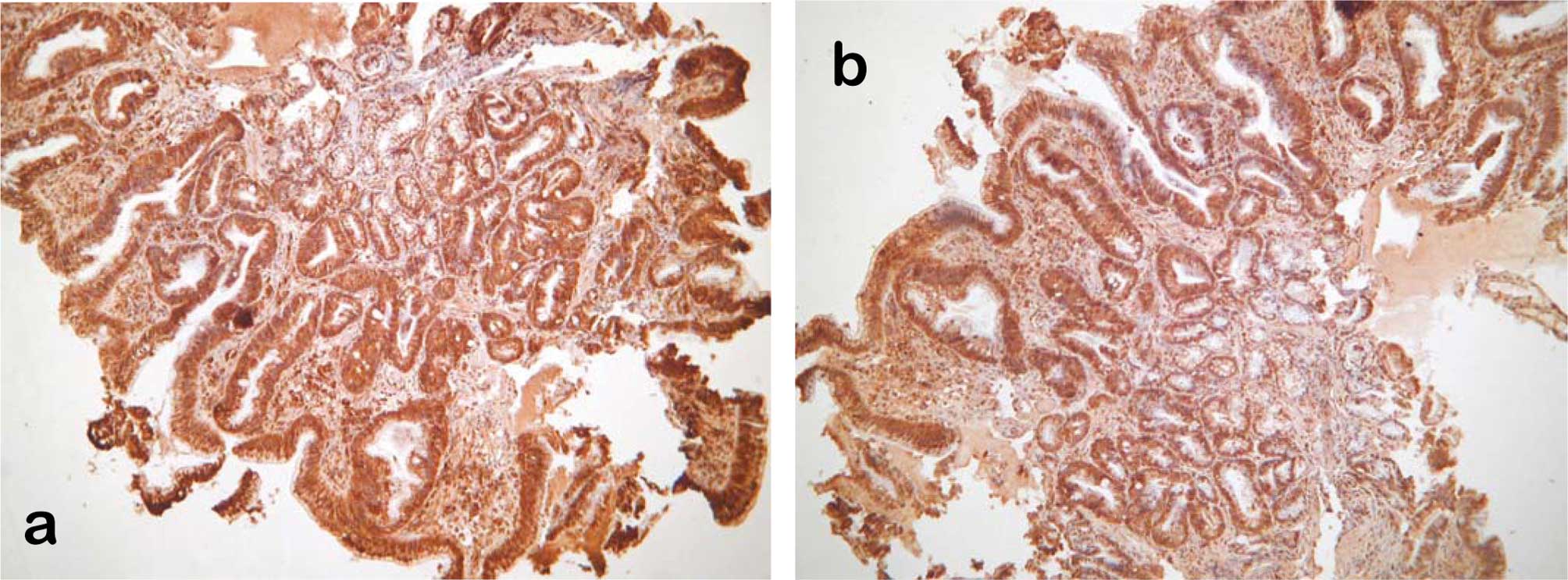|
1
|
Fan X and Snyder N: Prevalence of
Barrett’s esophagus in patients with or without GERD symptoms: role
of race, age, and gender. Dig Dis Sci. 54:572–577. 2009.
|
|
2
|
Ramus JR, Caygill CP, Gatenby PA and
Watson A: Current United Kingdom practice in the diagnosis and
management of columnar-lined oesophagus: results of the United
Kingdom National Barrett’s Oesophagus Registry endoscopist
questionnaire. Eur J Cancer Prev. 17:422–425. 2008.PubMed/NCBI
|
|
3
|
Guillem PG: How to make a Barrett
esophagus: pathophysiology of columnar metaplasia of the esophagus.
Dig Dis Sci. 50:415–424. 2005. View Article : Google Scholar : PubMed/NCBI
|
|
4
|
Hattori T, Mukaisho K and Miwa K:
[Pathogenesis of Barrett’s esophagus – new findings in the
experimental studies of duodenal reflux models]. Nippon Rinsho (in
Japanese). 63:1341–1349. 2005.
|
|
5
|
Tang LH and Klimstra DS: Barrett’s
esophagus and adenocarcinoma of the gastroesophageal junction: a
pathologic perspective. Surg Oncol Clin N Am. 15:715–732. 2006.
|
|
6
|
Jaskiewicz K, Louw J and Anichkov N:
Barrett’s oesophagus: mucin composition, neuroendocrine cells, p53
protein, cellular proliferation and differentiation. Anticancer
Res. 14:1907–1912. 1994.
|
|
7
|
Rustgi AK: Models of esophageal
carcinogenesis. Semin Oncol. 33:S57–S58. 2006. View Article : Google Scholar : PubMed/NCBI
|
|
8
|
Lagorce-Pages C, Paraf F, Dubois S,
Belghiti J and Flejou JF: Expression of CD44 in premalignant and
malignant Barrett's oesophagus. Histopathology. 32:7–14. 1998.
View Article : Google Scholar : PubMed/NCBI
|
|
9
|
Menges M, Goebel R, Pueschel W, Zeitz M
and Stallmach A: Expression of CD44v5 and -v6 in Barrett’s
carcinoma is not increased compared to that in nondysplastic
Barrett’s mucosa. Exp Mol Pathol. 72:207–212. 2002.
|
|
10
|
Montgomery EA: Biopsy Interpretation of
Gastrointestinal Tract Mucosa. Lippincott Williams & Wilkins;
pp. 37–70. 2005
|
|
11
|
Chen FL, Wang XZ, Li JY, Yu JP, Huang CY
and Chen ZX: 12-lipoxygenase induces apoptosis of human gastric
cancer AGS cells via the ERK1/2 signal pathway. Dig Dis Sci.
53:181–187. 2008. View Article : Google Scholar : PubMed/NCBI
|
|
12
|
Chen X, Wang S, Wu N, et al:
Overexpression of 5-lipoxygenase in rat and human esophageal
adenocarcinoma and inhibitory effects of zileuton and celecoxib on
carcinogenesis. Clin Cancer Res. 10:6703–6709. 2004. View Article : Google Scholar : PubMed/NCBI
|
|
13
|
Bednar W, Holzmann K and Marian B:
Assessing 12(S)-lipoxygenase inhibitory activity using colorectal
cancer cells overexpressing the enzyme. Food Chem Toxicol.
45:508–514. 2007. View Article : Google Scholar : PubMed/NCBI
|
|
14
|
Gong Z, Hebert JR, Bostick RM, et al:
Common polymorphisms in 5-lipoxygenase and 12-lipoxygenase genes
and the risk of incident, sporadic colorectal adenoma. Cancer.
109:849–857. 2007. View Article : Google Scholar : PubMed/NCBI
|
|
15
|
Hoque A, Lippman SM, Wu TT, et al:
Increased 5-lipoxygenase expression and induction of apoptosis by
its inhibitors in esophageal cancer: a potential target for
prevention. Carcinogenesis. 26:785–791. 2005. View Article : Google Scholar : PubMed/NCBI
|
|
16
|
Skrzypczak-Jankun E, Chorostowska-Wynimko
J, Selman SH and Jankun J: Lipoxygenases – a challenging problem in
enzyme inhibition. Current Enzyme Inhibition. 3:119–132. 2007.
|
|
17
|
Castella E, Ariza A, Fernandez-Vasalo A,
Roca X and Ojanguren I: Expression of CD44H and CD44v3 in normal
oesophagus, Barrett mucosa and oesophageal carcinoma. J Clin
Pathol. 49:489–492. 1996. View Article : Google Scholar : PubMed/NCBI
|
|
18
|
Gulmann C, Grace A, Leader M, Butler D,
Patchett S and Kay E: CD44v6: a potential marker of malignant
transformation in intestinal metaplasia of the stomach? An
immunohistochemical study using tissue microarrays. Eur J
Gastroenterol Hepatol. 15:981–986. 2003. View Article : Google Scholar : PubMed/NCBI
|










